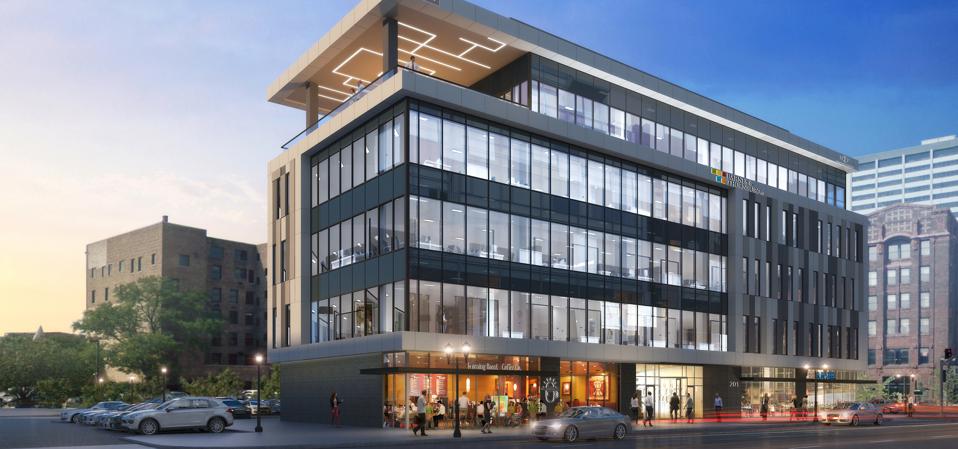The Barnes & Thornburg Building in South Bend, Ind., designed by KTGY Architecture + Planning, … [+]
KTGY Architecture + Planning
Over the course of human history, people have spent most of their days in natural environments. Only in recent times has the built environment replaced the natural world as a habitat for much of human life. Scant wonder people tend to enjoy and be at their best around trees, flowers, grass, shrubs, water and other natural elements. We are prewired to be healthier in nature.
That’s the thought behind biophilic design, a building industry concept aiming to boost occupant connections to the natural world, including plants, natural light, patterns, color and natural material palettes. It’s a concept just right for today’s pandemic-sparked emphasis on healthier work spaces. First explored 40 years ago, biophilic design has steadily gained champions since. The trend could mean future offices occupied by fewer folks and more greenery.
One of the finest exemplars of biophilic design among new or newer buildings is the Barnes & Thornburg Building, designed by the Chicago office of KTGY Architecture + Planning, in downtown South Bend, Ind. More about the building’s biophilic design features a bit later in this article.
Mood improvement
Among entities taking note of the movement toward biophilic design is the New York City, N.Y.-based International WELL Building Institute (IWBI).
It reports direct links with nature through plants, water, light and views, as well as indirect connection via natural materials, colors and patterns, have been linked to mood improvement, concentration and recovery from stress.
“For example, studies have shown that when contact with nature is increased during the work day, perceived job stress, subjective heath complaints and sickness-related absences decreased,” says Rachel Gutter, IWBI president.
“Since stress is also known to weaken the immune system and chronic stress is associated with increased risk of numerous adverse health consequences, this becomes increasingly important during health crises.”
Strong preference
Research has proven use of biophilic design yields health benefits. A study by Denmark’s Aarhus University found that when green space encircles children, their odds of developing mental disorders later in life fall 55 percent. Cornell University research revealed daylit environments were linked with reduced eye strain, headaches and blurred vision among workers. And when given a choice between fitness clubs and nature, workers chose the latter.
“Even before the pandemic, interest in healthy and sustainable buildings was on the rise,” says John Miade, LFA, WELL Faculty, LEED Fellow and senior project manager, sustainable and healthy environments, at design-build firm Wight & Company in Chicago.
“Research from the U.S. Green Building Council indicates a strong preference among employees for these types of work environments. Given the health and productivity benefits associated with biophilic design, we expect to see more building owners and companies integrating biophilic elements into their workplaces.”
Natural light
KTGY Architecture + Planning infuses biophilic design elements into many of the buildings it designs. Among them: The mixed-use office project called the Barnes & Thornburg Building, anchored by law firm Barnes & Thornburg LLP.
Its glass-and-steel-clad office floors feature particularly efficient floor plates, inviting abundant natural light to flood the building’s interior area through floor-to-ceiling windows. Interior space is extended outdoors via the inclusion of fourth- and fifth-level terraces. The terraces, designed to give building tenants a touch of green space and fresh air, allow building employees to hold meetings or meals outdoors during Northern Indiana’s warmer seasons.
“The building design includes large expanses of glass curtainwall, which allows for natural light to penetrate deep into the building interiors, bringing the outdoors in,” says Craig Pryde, a firm principal. “And office tenants on the upper floors can actually take their work outside via the outdoor terraces.”
The terraces are one option for meetings that require social distancing, Pryde adds. They also offer access to the outdoors and, he says, “an opportunity to connect with nature during the work day.”
